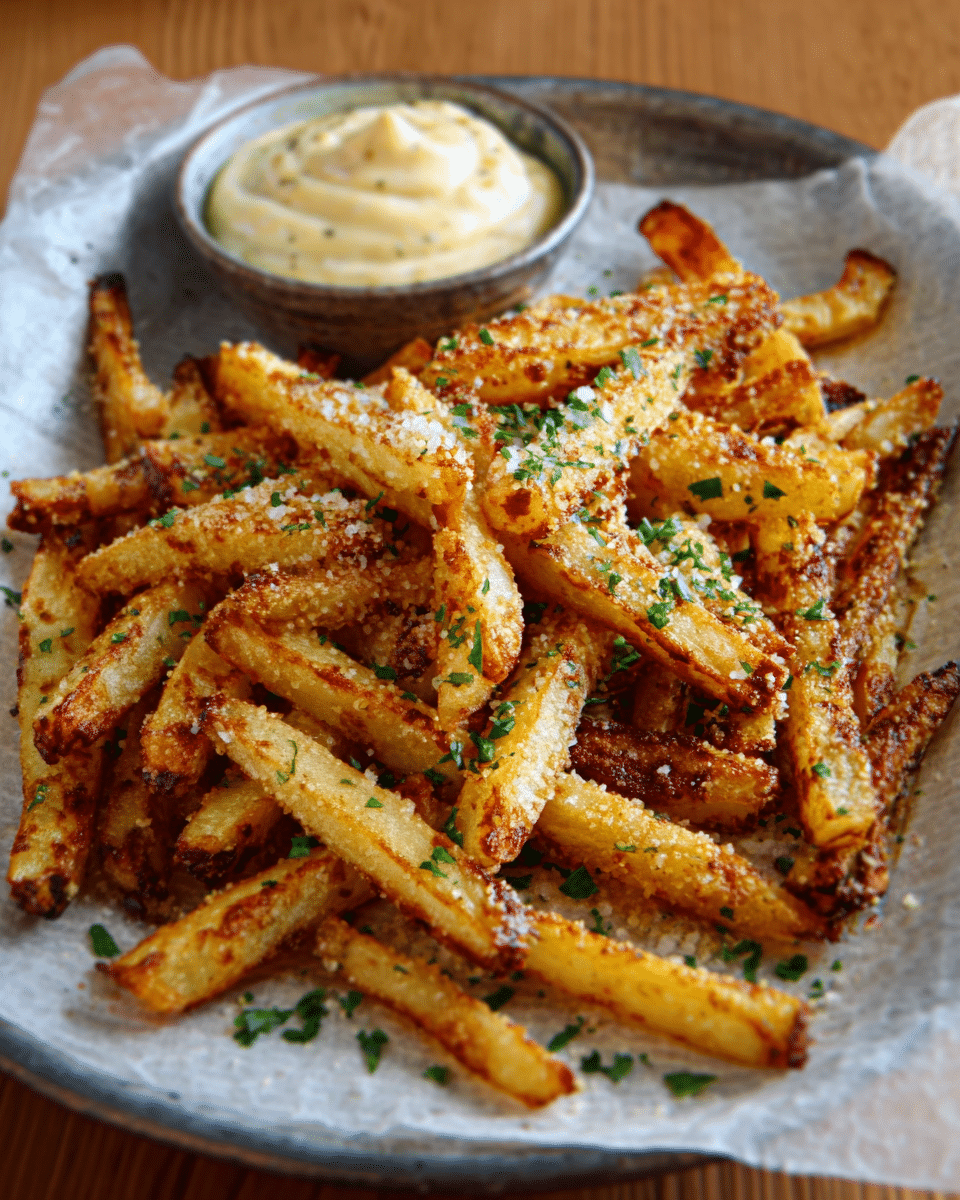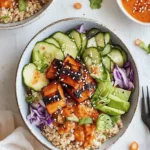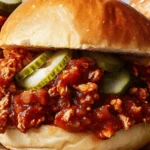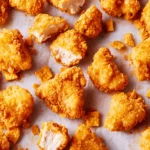These crispy kohlrabi fries are a healthy and delicious alternative to traditional French fries. With a mild flavor and satisfying crunch, they’re oven-baked to golden perfection and seasoned simply for maximum taste with minimal guilt. Great as a snack, side dish, or appetizer.
FULL RECIPE
Ingredients
- 2 medium kohlrabi bulbs, peeled and cut into fry-shaped sticks
- 1 ½ tablespoons olive oil
- ½ teaspoon garlic powder
- ½ teaspoon smoked paprika
- ¼ teaspoon salt (or to taste)
- ¼ teaspoon freshly ground black pepper
- Optional: 2 tablespoons grated Parmesan or nutritional yeast for extra flavor
- Optional: chopped parsley or chives for garnish
Directions
- Preheat your oven to 425°F (220°C). Line a baking sheet with parchment paper.
- Peel the kohlrabi bulbs and cut them into uniform sticks resembling French fries.
- In a large bowl, toss the kohlrabi sticks with olive oil, garlic powder, smoked paprika, salt, and pepper until evenly coated.
- Arrange the fries in a single layer on the prepared baking sheet, making sure they don’t overlap.
- Bake for 20–25 minutes, flipping halfway through, until the fries are golden and crispy on the edges.
- (Optional) Sprinkle with Parmesan or nutritional yeast during the last 5 minutes of baking.
- Remove from the oven and let cool for 2–3 minutes. Garnish with herbs if desired. Serve immediately.
Nutrition Facts
- Calories: 95
- Fat: 5.5g
- Saturated Fat: 0.8g
- Carbohydrates: 10g
- Fiber: 3g
- Sugars: 4g
- Protein: 2g
- Sodium: 190mg
What Makes Kohlrabi a Unique Vegetable?
Kohlrabi, often called the “German turnip,” is a lesser-known member of the cabbage family that offers a crisp texture and a mildly sweet, peppery flavor. Unlike root vegetables, kohlrabi is actually a swollen stem, which contributes to its crunchy bite. Its pale green or purple skin encloses a juicy, white flesh that holds its texture well when cooked, making it incredibly versatile in the kitchen. This unique vegetable bridges the gap between root vegetables and leafy greens, offering nutritional benefits from both worlds.
Health Benefits of Kohlrabi Fries
Kohlrabi is packed with vitamins, fiber, and antioxidants, making these fries a nutritious alternative to traditional potato fries. It is particularly rich in vitamin C, which supports immune health and skin vitality. The fiber content promotes healthy digestion and helps maintain steady blood sugar levels. Additionally, kohlrabi contains compounds like glucosinolates that may have anti-inflammatory and cancer-protective effects. By baking the fries instead of frying, you avoid the unhealthy fats and excess calories, making this recipe a guilt-free indulgence.
Why Oven-Baking is Better Than Frying
Oven-baking kohlrabi fries offers a healthier cooking method that reduces the amount of oil absorbed during cooking. Unlike deep frying, baking uses minimal oil, preserving the natural nutrients of the vegetable while producing a crispy texture. It also prevents the formation of harmful compounds that can develop at high frying temperatures. This cooking technique makes it easier to control seasoning and avoid excess salt or fat, resulting in a lighter, yet flavorful snack or side dish.
Seasoning Ideas Beyond the Basics
While garlic powder, smoked paprika, salt, and pepper provide a simple and satisfying flavor profile, kohlrabi fries can be customized with a wide variety of seasonings. For a spicy kick, try adding cayenne pepper or chili powder. Herbs like rosemary, thyme, or oregano work wonderfully for a more aromatic experience. Nutritional yeast can add a cheesy, umami depth for vegan eaters, while a sprinkle of Parmesan elevates the savory profile. Experimenting with different seasonings allows you to tailor the fries to suit different cuisines and personal preferences.
Serving Suggestions for Kohlrabi Fries
Kohlrabi fries can be enjoyed on their own as a healthy snack or paired with various dips and sauces. Classic options like ketchup, garlic aioli, or spicy sriracha mayo complement the crispy texture well. For a Mediterranean twist, serve with tzatziki or hummus. They also make a great side dish alongside grilled meats, roasted vegetables, or burgers, adding a crunchy contrast. For a full meal, consider serving them with a fresh salad or as a topping for grain bowls.
Variations to Try with Kohlrabi Fries
There are numerous ways to adapt this recipe depending on dietary needs and taste preferences. For a lower-fat version, reduce the olive oil slightly or use a cooking spray. To add extra protein, toss the fries with chickpea flour or nutritional yeast for a coating before baking. If you prefer a softer texture, parboil the kohlrabi sticks briefly before seasoning and baking. You can also experiment by mixing in other root vegetables like carrots or parsnips for a colorful fry medley.
Tips for Selecting and Preparing Kohlrabi
When buying kohlrabi, look for bulbs that are firm, smooth, and free from blemishes or cracks. Smaller bulbs tend to be more tender and less woody than larger ones. Avoid those with soft spots or signs of wilting. Before cutting, remove the tough outer skin with a sharp knife or vegetable peeler to reveal the crisp white flesh. For even cooking, try to cut the fries into uniform sizes. Kohlrabi leaves are edible too and can be sautéed or added to salads for a nutrient boost.
Storage and Shelf Life of Kohlrabi Fries
Raw kohlrabi can be stored in the refrigerator for up to two weeks when kept in a plastic bag or container to retain moisture. Once cut into fries, it’s best to bake them immediately for optimal crispness. If you have leftovers, store cooked fries in an airtight container in the refrigerator for up to three days. To reheat, use the oven or an air fryer to regain their crisp texture—avoid microwaving, which can make them soggy. Proper storage helps preserve flavor and texture while minimizing waste.
Nutritional Comparison: Kohlrabi Fries vs. Potato Fries
While both kohlrabi and potatoes provide carbohydrates, kohlrabi fries offer fewer calories and carbs per serving, making them a better option for those watching their intake. Kohlrabi’s higher fiber and vitamin C content add nutritional value that traditional fries lack. Potatoes often require deep frying, increasing fat and calorie content, whereas these kohlrabi fries are oven-baked with minimal oil. This makes kohlrabi fries not only a tasty but also a nutrient-dense choice for health-conscious individuals.
How to Achieve the Perfect Crispiness
Achieving crispy kohlrabi fries can be a challenge due to their high water content. To maximize crunch, it’s helpful to dry the cut kohlrabi sticks thoroughly before tossing them in oil and seasoning. Using a hot oven and spacing the fries apart on the baking sheet allows hot air to circulate, preventing steaming and sogginess. Flipping the fries halfway through baking promotes even browning. Adding a small amount of cornstarch or arrowroot powder before baking can also help create a crispy outer layer without overpowering the natural flavor.
Conclusion
Crispy oven-baked kohlrabi fries are a versatile, nutritious, and delicious alternative to traditional fries. Their unique texture and subtle flavor make them an excellent addition to any meal or a standalone snack. Packed with health benefits and easy to customize, they suit a variety of dietary preferences and taste profiles. By choosing oven-baking over frying, you get to enjoy a satisfying crunch without the added guilt. Whether you’re seeking new ways to enjoy vegetables or aiming to create healthier comfort food, kohlrabi fries are a fantastic option to try.






